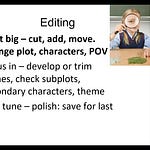Welcome back to Write Better Right Now. I’m working on a series of videos about editing that will go from the big picture down to line editing issues, but before that, I want to share a short tip today that can help with plotting. It's a way that you can potentially plug plot holes.
This came from Sid Fleischman, who was a wonderful children's book author and a great teacher. I heard him speak at some conferences and in one of his talks he mentioned, “If there's a hole in your story, point it out and the hole will disappear.”
This may seem counterintuitive. If there's a hole, don't you want to hope that nobody will notice it? So maybe you should pretend it's not there. But that doesn't usually work because the reader is noticing, Wait, what about this thing?
Instead, sometimes it works much better to address the issue head on. Just acknowledging it can be enough to let the reader relax about it.
Sid gave an example from his book, McBroom's Zoo. This is a tall tale, and it involves a hidebehind, which is a mythical creature that is always hiding behind you, so it's impossible to see what it looks like. But Sid wondered, “Why couldn't someone just use a mirror to look behind them?” He couldn't come up with a good answer, so instead he pointed out the problem.
I even tried walking around with a hand mirror, but the hidebehind was too eternal clever for tricks like that.
So he doesn't explain what the hidebehind does or why this trick doesn't work. He just acknowledges that it seems logical to use a mirror, and he says, that doesn't work. The reader can then let go of the idea of “Why aren't you using a mirror?” and go along with the rest of the story.
You can use this kind of technique in a novel too. Say you want your characters to stumble upon a crime scene of some sort, but you don't want them to call the police right away. An example of pointing out the problem might be something like:
I don't know why we didn't call the police right away. It honestly didn't occur to us.
It's a little tricky. It would probably work pretty well if your characters are children or teens who might not immediately think about going to the adults or calling the police. It could certainly work if the characters have been drinking. But for other characters, you might want to give them a reason why they don't think about calling the police.
You generally want your characters to behave in a way that makes sense for that character in that world in that particular situation. You can do that by setting up the character's personality or by setting up some backstory – maybe they are very suspicious of the police from previous experiences. Calling them is just not something that they would do except as a last resort.
You can also get deeper into the point of view so the reader really feels what that character is feeling. We recognize the sort of fight or flight or freeze response that can happen in stressful situations. If you can capture that, it might let the reader know why your character is not behaving how people should behave in those situations.
I know I should have called the police right away, but all I could do is stare at the body, trying not to pass out or throw up.
That's only going to work for a certain amount of time until that character has to think and make decisions again. But it can be a good way to delay the behavior that you don't want right away.
At a retreat, I critiqued a manuscript that was based on a real experience. It involved a teen girl's older brother dying, and she goes with her mom to the funeral home. As I was reading through the scene where the mom and the funeral home director are talking, I said, “I can't believe that he would actually say that.” And the writer said, “But that's how it happened.” A little bit later, I said, “I can't believe Mom would actually do that.” And the writer said, “But that's how it happened.”
Finally, I said, “That's how it happened isn't good enough.”
If you're writing nonfiction, you build the reader's trust that you're going to tell us the truth, so we go with it, even if it seems extreme. But when you're writing a novel, it has to feel real, not necessarily be real.
In reality, truth is stranger than fiction. But we have to make the stories feel real, no matter how strange they are. There's several ways that writer could address the issue. She could change that behavior if it's not key to the story. Or she could also have her character acknowledge how odd this situation seemed. As a teen character listening to these adults talk, she might think something like:
Why would he say that? I couldn't believe they were having that conversation. I'll never understand grownups.
Most teens will be able to nod and say, “Yeah, grownups just act odd sometimes. They don't make sense.” The reader can let go of the question because you've given them an answer: Grownups are weird. You can do this even with adult novels by acknowledging that a situation seems odd to your character too.
I hope that this is a technique you might be able to use to plug a plot hole at some point. I'll try to get an editing video ready for next week. Thanks for being here.









